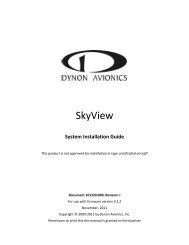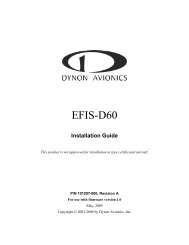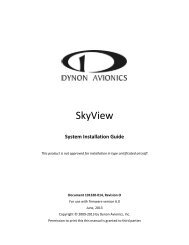EFIS-D100 Installation Guide - Dynon Avionics
EFIS-D100 Installation Guide - Dynon Avionics
EFIS-D100 Installation Guide - Dynon Avionics
Create successful ePaper yourself
Turn your PDF publications into a flip-book with our unique Google optimized e-Paper software.
Instrument <strong>Installation</strong><br />
Serial Communication Cable<br />
More Information Is Available Online: Serial communication to non-<strong>Dynon</strong> devices,<br />
and interfacing of other devices in general can be involved and detailed. This <strong>Installation</strong><br />
<strong>Guide</strong> is intended to provide general installation advice for the most common devices and<br />
situations. <strong>Dynon</strong>’s Documentation Wiki provides enhanced, extended, frequently<br />
updated online documentation contributed by <strong>Dynon</strong> employees and customers at<br />
wiki.dynonavionics.com.<br />
The <strong>EFIS</strong>-<strong>D100</strong> has one RS-232 serial port that can be used for several purposes. This serial port<br />
can only be configured for one purpose at a time.<br />
The <strong>EFIS</strong> Serial port (DB25) is used for:<br />
<br />
<br />
<br />
Connecting to a PC, and using the <strong>Dynon</strong> <strong>Avionics</strong> Product Support Program to perform<br />
firmware upgrades, configure checklists, and download internal logs. The Help Files of<br />
the Support Program provide detailed instructions on these functions. The latest version<br />
of the Product Support Program is available on the <strong>Dynon</strong> web site at<br />
downloads.dynonavionics.com.<br />
Connecting serial devices such as a GPS receiver or an SL30.<br />
“Streaming” real-time <strong>EFIS</strong> flight data to an external serial device for recording. For data<br />
formats and other information, see the Appendix in the <strong>EFIS</strong>-<strong>D100</strong> Pilot’s User <strong>Guide</strong>.<br />
Note that for the purposes of logging data, version 5.0 of <strong>EFIS</strong>-<strong>D100</strong> firmware added<br />
internal data logging and retrieval via the <strong>Dynon</strong> Product Support Program.<br />
When an optional HS34 Expansion Module is connected to your <strong>Dynon</strong> DSAB network,<br />
all GPS and NAV radios must be connected to it. This simplifies the connection and<br />
usage of multiple serial devices. The HS34 also provides interfaces to non-serial devices<br />
such as those with only analog and ARINC-429 interfaces.<br />
PC USB CONNECTION<br />
If you do not have a serial port on your PC, use the included USB-to-Serial adapter to connect<br />
the <strong>EFIS</strong>-<strong>D100</strong> to your PC’s USB port. If you are using Windows 2000 or XP, ensure that the<br />
adapter driver CD is inserted in your PC before plugging the adapter into the USB port for the<br />
first time. If you are using Windows Vista, ensure that you are connected to the Internet and do<br />
not use the driver CD; the operating system will download the correct driver. Also, do not have<br />
your <strong>EFIS</strong>-<strong>D100</strong> plugged into the USB-to-Serial adapter while installing the driver.<br />
<strong>EFIS</strong> SERIAL HARNESS<br />
On the <strong>EFIS</strong> 25-pin wiring harness<br />
available from <strong>Dynon</strong>, there are three<br />
wires bundled together, terminating in a<br />
standard DB9-pin female connector. This<br />
cable is 6’ long and pre-assembled for<br />
connection to a PC-based laptop. Route<br />
this cable to a convenient location that can<br />
<strong>EFIS</strong><br />
DB25<br />
Pin#<br />
DB9<br />
Pin#<br />
Wire<br />
Color<br />
RS-232 Function<br />
9 5 Black Signal ground<br />
10 2 Orange <strong>EFIS</strong>-<strong>D100</strong> transmit /<br />
device receive<br />
22 3 Yellow <strong>EFIS</strong>-<strong>D100</strong> receive /<br />
device transmit<br />
3-4 <strong>EFIS</strong>-<strong>D100</strong> <strong>Installation</strong> <strong>Guide</strong>
















